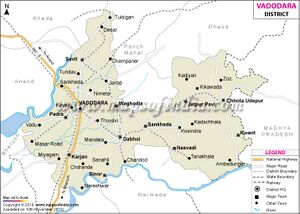Karvan
| Author:Laxman Burdak, IFS (R) |
Karvan (Hindi:करवान, Gujarati: કરવાં) or Kayavarohan is a historical village in Vadodara district of Gujarat. Kayavarohan is popularly known as Karvan. Some remains of Solanki period (10th century) have been found at this village. It is an important religious place on account of its Lakulisha temple.
Contents
Location
It is situated on the National Highway 8 at a distance of 30 km from Vadodara. Its geographical coordinates are 22° 4' 0" North, 73° 15' 0" East.
Variants
- Kayavarohan (कायावरोहन)
- Karavana (करवान) (जिला बड़ौदा, गुजरात) (AS, p.140)
History
Kayavarohan (Karvan) is an ancient town believed to have existed through each of the Four Ages. As per Shaivite mythology, Lord Shiva in the Lakulish manifestation appeared at this place. According to mythology and puranas, from here Lord Shiva transmigrated into the form of a Brahmin child. Thus the place came to be known as Kayavarohan [Kaya (Body) + Avarohan (Descent) = Where the body of the Lord has descended]. It is an ancient town believed to have existed through each of the Four Ages according to the Hindus. According to a popularly held belief, it was from here that Lord Shiva in the guise of a child transmigrated after death and his body disappeared. Thus the place came to be known as Kayavarohan. A number of copper coins and a stone quern have been found from here. A beautiful head of Tapas, the image of Kartikeya and an idol of Uma Maheshwara are some of the archaeological specimen discovered from here. Kayavarohan is also famous for its healthy environment
Kayavarohan is considered as the birthplace of Lakulisha, the 2nd Century C.E. Shaivite revivalist, reformer and propounder of the pashupata doctrine.
Excavations at Kayavarohan
The village and its surrounding areas are of great archaeological significance. Ancient sculptures and relics belonging to the 2nd century have been excavated from this place.
Later during the Dark Ages of Hinduism (Muslim invasions and subsequent reign from 11th century CE. to 17th century CE), starting with the attacks of barbarian Muslim marauder Mahmud Ghazni, who looted and destroyed the temple of Somnath in Gujarat, all the Shiva temples at Karvan were desecrated and razed by the iconoclast Muslim invaders. However, the Shiva Lingas of the destroyed temples still survive and remain at the site, without temples around them.
The temple of Lakulish and temples of Karvan were rebuilt and restored during the late twentieth century by the Hindu spiritual leader Kripalvanand.[1]
Numerous Hindu icons, number of copper coins and a stone quern have been found from Kayavarohan. A grand head of Tapasvi, the image of Kartikeya and an idol of [[Uma Maheshwara[[ are some of the rare and unmatched archaeological specimen discovered from Kayavarohan. Kayavarohan is a place of great archaeological importance and the A.S.I. Archaeological Survey of India has listed Karvan as a heritage site and has set up a special museum for the remains found around this site. Karvan is one of the major sites of Indian Heritage.
करवान
विजयेन्द्र कुमार माथुर[2] ने लेख किया है ...करवान (AS, p.140) गुजरात के वडोदरा ज़िले में स्थित है। करवान से उत्खनन द्वारा पूर्व सोलंकी कालीन (10वीं शती ई.) मंदिर के अवशेष प्रकाश में लाए गए है।
External links
http://www.onefivenine.com/india/villages/Surat/Mahuva/Karvan
References
- ↑ Constance Jones; James D. Ryan (2006). Encyclopedia of Hinduism. Infobase Publishing. p. 238. ISBN 978-0-8160-7564-5.
- ↑ Aitihasik Sthanavali by Vijayendra Kumar Mathur, p.140
